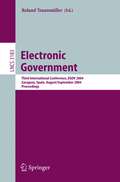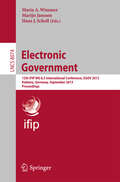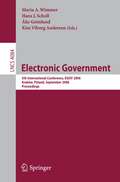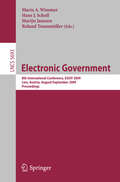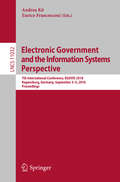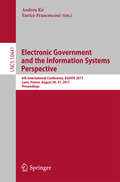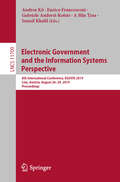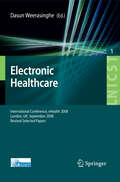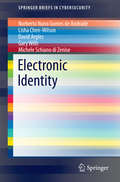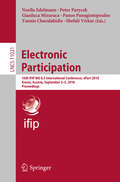- Table View
- List View
Electronic Government: Third International Conference, EGOV 2004, Zaragoza, Spain, August 30-September 3, 2004, Proceedings (Lecture Notes in Computer Science #3183)
by Roland TraunmüllerElectronic Government: 12th IFIP WG 8.5 International Conference, EGOV 2013, Koblenz, Germany, September 16-19, 2013, Proceedings (Lecture Notes in Computer Science #8074)
by Maria A. Wimmer Marijn Janssen Hans Jochen SchollThis book constitutes the refereed proceedings of the 12th IFIP WG 8.5 International Conference on Electronic Government, EGOV 2013, held in Koblenz, Germany, in September 2013. The 27 revised full papers presented were carefully reviewed and selected for inclusion in this volume. The papers have been organized in the following topical sections: research foundations; open government data and transparency; service design and improvement; adoption and service evaluation; and social media and social network analysis.
Electronic Government: 5th International Conference, EGOV 2006, Krakow, Poland, September 4-8, 2006, Proceedings (Lecture Notes in Computer Science #4084)
by Maria A. Wimmer Hans Jochen Scholl Ake Grönlund Kim Viborg AndersenThis book presents the refereed proceedings of the 5th International Conference on Electronic Government, EGOV 2006, held in in Krakow, Poland in conjunction with DEXA 2006. The book offers 31 revised papers depicting the state of the art in e-government/ e-governance, arranged in topical sections on research, review and outlook, participation and democracy, designing government services, legal dimensions in e-government, procurement and governance issues in networked governments, and more.
Electronic Government: 8th International Conference, EGOV 2009, Linz, Austria, August 31 - September 3, 2009, Proceedings (Lecture Notes in Computer Science #5693)
by Maria A. Wimmer Hans Jochen Scholl Marijn Janssen Roland TraunmüllerElectronic Government and the Information Systems Perspective: 7th International Conference, EGOVIS 2018, Regensburg, Germany, September 3–5, 2018, Proceedings (Lecture Notes in Computer Science #11032)
by Andrea Kő Enrico FrancesconiThis book constitutes the refereed proceedings of the 7th International Conference on Electronic Government and the Information Systems Perspective, EGOVIS 2018, held in Regensburg, Germany, in September 2018. The 19 revised full papers presented were carefully reviewed and selected from 22 submissions. The papers are organized in the following topical sections: digitalization and transparency; challenges in e-government technology and e-voting; knowledge management in the context of e-government; semantic technologies and the legal aspects; open data and open innovation; and e-government cases - data and knowledge management.
Electronic Government and the Information Systems Perspective: 6th International Conference, EGOVIS 2017, Lyon, France, August 28-31, 2017, Proceedings (Lecture Notes in Computer Science #10441)
by Andrea Kő Enrico FrancesconiThis book constitutes the refereed proceedings of the 6th International Conference on Electronic Government and the Information Systems Perspective, EGOVIS 2017, held in Lyon, France, in August 2017. The 20 revised full papers presented were carefully reviewed and selected from 24 submissions. The papers areorganized in the following topical sections: digitalization and transparency; open data ecosystems; intelligent systems in e-government; e-government research and intelligent systems; m-government and inclusion; e-government cases - data knowledge management; and knowledge management in the context of e-government.
Electronic Government and the Information Systems Perspective: 8th International Conference, EGOVIS 2019, Linz, Austria, August 26–29, 2019, Proceedings (Lecture Notes in Computer Science #11709)
by Andrea Kő Enrico Francesconi Gabriele Anderst-Kotsis A Min Tjoa Ismail KhalilThis book constitutes the refereed proceedings of the 8th International Conference on Electronic Government and the Information Systems Perspective, EGOVIS 2019, held in Linz, Austria, in August 2019. The 17 full papers presented were carefully reviewed and selected from 25 submissions. The papers are organized in the following topical sections: open data and open innovation; data-driven approaches in e-government; e-government cases – data and knowledge management; e-government theoretical background; and digitalization and transparency.
Electronic Healthcare: First International Conference, eHealth 2008, London, September 8-9, 2008, Revised Selected Papers (Lecture Notes of the Institute for Computer Sciences, Social Informatics and Telecommunications Engineering #1)
by Dasun WeerasingheeHealth 2008, the First International Conference on Electronic healthcare for the twenty-first century, was held in City University, London, during September 8–9, 2008. The conference was organized as a meeting point for telecare product vendors, policy makers, government ministers, academics, clinicians and all those involved in electronic and mobile health, to examine and to share ideas contributing to the - vancement of electronic healthcare into the twenty-first century. The conference had a huge success with a large number of paper submissions. Ninety-seven papers were submitted, of which 32 were selected for presentation. Each paper was carefully reviewed blindly by a minimum of three referees from the resp- tive field. A special thanks should go to the Technical Program Committee for their hard and efficient work in the review process. In addition to the submitted contributions, the conference included a business pres- tation track with 12 invited talks by key people in the world of eHealth. The business presentation track was chaired by Sir Jonathan Michael (Deputy Director, BT Health). The success of this conference is to be credited to the contribution of many people.
Electronic Identity (SpringerBriefs in Cybersecurity)
by Norberto Nuno de Andrade Lisha Chen-Wilson David Argles Gary Wills Michele Schiano di ZeniseWith the increasing availability of electronic services, security and a reliable means by which identity is verified is essential.Written by Norberto Andrade the first chapter of this book provides an overview of the main legal and regulatory aspects regarding electronic identity in Europe and assesses the importance of electronic identity for administration (public), business (private) and, above all, citizens. It also highlights the role of eID as a key enabler of the economy.In the second chapter Lisha Chen-Wilson, David Argles, Michele Schiano di Zenise and Gary Wills discuss the user-centric eCertificate system aimed at supporting the eID system.Electronic Identity is essential reading for researchers, lawyers, policy makers, technologists and anyone wishing to understand the challenges of a pan-European eID.
Electronic Imaging in Astronomy: Detectors and Instrumentation (Springer Praxis Books)
by Ian S. McLeanThe second edition of Electronic Imaging in Astronomy: Detectors and Instrumentation describes the remarkable developments that have taken place in astronomical detectors and instrumentation in recent years – from the invention of the charge-coupled device (CCD) in 1970 to the current era of very large telescopes, such as the Keck 10-meter telescopes in Hawaii with their laser guide-star adaptive optics which rival the image quality of the Hubble Space Telescope. Authored by one of the world’s foremost experts on the design and development of electronic imaging systems for astronomy, this book has been written on several levels to appeal to a broad readership. Mathematical expositions are designed to encourage a wider audience, especially among the growing community of amateur astronomers with small telescopes with CCD cameras. The book can be used at the college level for an introductory course on modern astronomical detectors and instruments, and as a supplement for a practical or laboratory class.
Electronic Interpretation of Organic Chemistry: A Problems-Oriented Text
by F. M. MengerMost standard texts in basic organic chemistry require the student to memorize dozens of organic reactions. This is certainly necessary to master the discipline. Unfortunately, most texts do not emphasize why these reactions occur and, just as important, why other reactions that might seem conceivable to the student do not occur. Without this understanding, students tend to forget what they have memorized soon after the course is over. It is the purpose of this book to familiarize the student with the principles governing organic reactivity and to provide a "feel" for organic chemistry that is impossible to secure by memory alone. Digesting the ideas in this book will, we hope, not only explain the common organic reactions but also allow the student to predict the prod ucts and by-products of reactions he has never seen before. Indeed, the creative student might even become capable of designing new reactions as might be required in a complex organic synthesis. In Chapter 1, we cover the basic principles including bonding, nuclear charge, resonance effects, oxidation-reduction, etc. It is a brief discussion, but it nonetheless provides the basis for understanding reaction mechanisms th~t will be treated later on. We highly recommend that this material be reviewed and that the v VI PREFACE problems be worked at the end of the chapter. Answers are given to all problems. In Chapter 2, reaction mechanisms are presented in an increas ing order of difficulty.
Electronic Inventions and Discoveries: Electronics from its earliest beginnings to the present day, Fourth Edition
by G.W.A DrummerIn a remarkably short time, electronics has penetrated almost every aspect of modern life and the pace of development in the field shows no sign of slackening. One of the first books to cover electronic inventions in depth, Electronic Inventions and Discoveries: Electronics from Its Earliest Beginnings to the Present Day, Fourth Edition traces the development of electronics from its earliest beginnings to the present day. Spanning a period of two and a half centuries, the book presents a mini-encyclopedia full of valuable information on practically all inventions in electronics from 1745 to 1996. This fourth edition has been brought up-to-date and made more attractive by a complete redesign while still maintaining the successful features of previous editions. The first nine chapters supply concise yet comprehensive histories of the main areas of the subject. Subsequent chapters provide a list of inventions by subject and succinct descriptions of each invention in date order with over 1,000 references. The book concludes with a list of acronyms and abbreviations, a list of books on inventions and inventors, and a comprehensive index.During his seventy years in the field, the author has collected a variety of published data to form an up-to-date systematic review of the major developments in electronics and the pattern of advances in electronic techniques. The book forms an essential source of reference to practicing engineers wishing to broaden their knowledge. Teachers and students who require a sound background and understanding of electronics will also find the book invaluable. Written in an easily understood largely nontechnical language, this fascinating and authoritative history of electronic developments will be of great interest to electronic hobbyists and general science readers.
Electronic Inventions and Discoveries: Electronics from its earliest beginnings to the present day, Fourth Edition
by G.W.A DrummerIn a remarkably short time, electronics has penetrated almost every aspect of modern life and the pace of development in the field shows no sign of slackening. One of the first books to cover electronic inventions in depth, Electronic Inventions and Discoveries: Electronics from Its Earliest Beginnings to the Present Day, Fourth Edition traces the development of electronics from its earliest beginnings to the present day. Spanning a period of two and a half centuries, the book presents a mini-encyclopedia full of valuable information on practically all inventions in electronics from 1745 to 1996. This fourth edition has been brought up-to-date and made more attractive by a complete redesign while still maintaining the successful features of previous editions. The first nine chapters supply concise yet comprehensive histories of the main areas of the subject. Subsequent chapters provide a list of inventions by subject and succinct descriptions of each invention in date order with over 1,000 references. The book concludes with a list of acronyms and abbreviations, a list of books on inventions and inventors, and a comprehensive index.During his seventy years in the field, the author has collected a variety of published data to form an up-to-date systematic review of the major developments in electronics and the pattern of advances in electronic techniques. The book forms an essential source of reference to practicing engineers wishing to broaden their knowledge. Teachers and students who require a sound background and understanding of electronics will also find the book invaluable. Written in an easily understood largely nontechnical language, this fascinating and authoritative history of electronic developments will be of great interest to electronic hobbyists and general science readers.
Electronic Irradiation of Foods: An Introduction to the Technology (Food Engineering Series)
by R. B. MillerFood irradiation, the use of ionizing radiation to destroy harmful biological organism in food, is a safe, proven process that has many useful applications. It has been endorsed by numerous health organizations and has now been approved for many applications by governments around the world. Electronic Irradiation of Foods describes all the key aspects of electron accelerator technology in detail. It emphasizes the physical science and technology aspects of food irradiation using machine sources of ionizing radiation. The book provides significant technical depth for interested workers and present descriptive, introductory material that should help demystify technology for businessmen to make informed choices regarding important investments decisions. Introductory chapters summarize the effects of ionizing radiation on biological organisms and the organic compounds comprising foods, and give an overview of the food irradiation process. Subsequent chapters cover the details of the electron beam and x-ray energy deposition, electron accelerator technologies, beam scanning systems, material handling systems, shielding design, and process control considerations. Important appendices cover radiation dosimetry, induced radioactivity, and ozone generation.
Electronic, Magnetic, and Optical Materials
by Pradeep Fulay Jung-Kun LeeThis book integrates materials science with other engineering subjects such as physics, chemistry and electrical engineering. The authors discuss devices and technologies used by the electronics, magnetics and photonics industries and offer a perspective on the manufacturing technologies used in device fabrication. The new addition includes chapters on optical properties and devices and addresses nanoscale phenomena and nanoscience, a subject that has made significant progress in the past decade regarding the fabrication of various materials and devices with nanometer-scale features.
Electronic Materials: A New Era in Materials Science (Springer Series in Solid-State Sciences #95)
by James R. Chelikowsky Alfonso FranciosiModem materials science is exploiting novel tools of solid-state physics and chemistry to obtain an unprecedented understanding of the structure of matter at the atomic level. The direct outcome of this understanding is the ability to design and fabricate new materials whose properties are tailored to a given device ap plication. Although applications of materials science can range from low weight, high strength composites for the automobile and aviation industry to biocompat ible polymers, in no other field has progress been more strikingly rapid than in that of electronic materials. In this area, it is now possible to predict from first principles the properties of hypothetical materials and to construct artificially structured materials with layer-by-Iayer control of composition and microstruc ture. The resulting superlattices, multiple quantum wells, and high temperature superconductors, among others, will dominate our technological future. A large fraction of the current undergraduate and graduate students in science and engi neering will be directly involved in furthering the revolution in electronic mate rials. With this book, we want to welcome such students to electronic materials research and provide them with an introduction to this exciting and rapidly de veloping area of study. A second purpose of this volume is to provide experts in other fields of solid state physics and chemistry with an overview of contemporary research within the field of electronic materials.
Electronic Materials Science
by Eugene A. IreneA thorough introduction to fundamental principles and applications From its beginnings in metallurgy and ceramics, materials science now encompasses such high- tech fields as microelectronics, polymers, biomaterials, and nanotechnology. Electronic Materials Science presents the fundamentals of the subject in a detailed fashion for a multidisciplinary audience. Offering a higher-level treatment than an undergraduate textbook provides, this text benefits students and practitioners not only in electronics and optical materials science, but also in additional cutting-edge fields like polymers and biomaterials. Readers with a basic understanding of physical chemistry or physics will appreciate the text's sophisticated presentation of today's materials science. Instructive derivations of important formulae, usually omitted in an introductory text, are included here. This feature offers a useful glimpse into the foundations of how the discipline understands such topics as defects, phase equilibria, and mechanical properties. Additionally, concepts such as reciprocal space, electron energy band theory, and thermodynamics enter the discussion earlier and in a more robust fashion than in other texts. Electronic Materials Science also features: * An orientation towards industry and academia drawn from the author's experience in both arenas * Information on applications in semiconductors, optoelectronics, photocells, and nanoelectronics * Problem sets and important references throughout * Flexibility for various pedagogical needs Treating the subject with more depth than any other introductory text, Electronic Materials Science prepares graduate and upper-level undergraduate students for advanced topics in the discipline and gives scientists in associated disciplines a clear review of the field and its leading technologies.
Electronic Monitoring of Feeding Behavior of Phytophagous True Bugs (Entomology in Focus #6)
by Antônio Ricardo Panizzi Tiago Lucini Paula Levin MitchellThis book compiles for the first time all the current information on the electronic monitoring of the feeding behavior of phytophagous true bugs. It includes state-of-the-art illustrations of feeding sites on the various plant structures, and examines how the different feeding strategies are related to the variable waveforms generated using the electropenetrography (EPG) technique. Further, the book describes the mouthparts and modes of feeding and discusses the physical and chemical damage resulting from feeding activities. Covering in detail all EPG studies developed and conducted using true bugs published to date, it explores the use of electronic monitoring of feeding coupled with histological analyses to improve strategies to control true bugs, from traditional chemical methods to gene silencing (RNAi).
Electronic Music Machines: The New Musical Instruments
by Jean-Michel ReveillacSince 1960, with the advent of musical electronics, composers and musicians have been using ever more sophisticated machines to create sonic material that presents innovation, color and new styles: electro-acoustic, electro, house, techno, etc. music. The music of Pierre Henry, Kraftwerk, Pink Floyd, Daft Punk and many others has introduced new sounds, improbable rhythms and a unique approach to composition and notation. Electronic machines have become essential: they have built and influenced the music of the most recent decades and set the trend for future productions. This book explores the theory and practice related to the different machines which constitute the universe of musical electronics, omitting synthesizers which are treated in other works. Sequencers, drum machines, samplers, groove machines and vocoders from 1960 to today are studied in their historical, physical and theoretical context. More detailed approaches to the Elektron Octatrack sequencer-sampler and the Korg Electribe 2 groove machine are also included.
Electronic Music Machines: The New Musical Instruments
by Jean-Michel ReveillacSince 1960, with the advent of musical electronics, composers and musicians have been using ever more sophisticated machines to create sonic material that presents innovation, color and new styles: electro-acoustic, electro, house, techno, etc. music. The music of Pierre Henry, Kraftwerk, Pink Floyd, Daft Punk and many others has introduced new sounds, improbable rhythms and a unique approach to composition and notation. Electronic machines have become essential: they have built and influenced the music of the most recent decades and set the trend for future productions. This book explores the theory and practice related to the different machines which constitute the universe of musical electronics, omitting synthesizers which are treated in other works. Sequencers, drum machines, samplers, groove machines and vocoders from 1960 to today are studied in their historical, physical and theoretical context. More detailed approaches to the Elektron Octatrack sequencer-sampler and the Korg Electribe 2 groove machine are also included.
Electronic Noses & Sensors for the Detection of Explosives (NATO Science Series II: Mathematics, Physics and Chemistry #159)
by J. Gardner Jehuda YinonThis book examines both the potential application of electronic nose technology, and the current state of development of chemical sensors for the detection of vapours from explosives, such as those used in landmines. The two fields have developed, somewhat in parallel, over the past decade and so one of the purposes of this workshop, on which the book is based, was to bring together scientists from the two fields in order to challenge the two communities and, mutually, stimulate both fields. It begins with a review of the basic principles of an electronic nose and explores possible ways in which the detection limit of conventional electronic nose technology can be reduced to the level required for the trace levels observed for many explosive materials. Next are reviews of the use of several different types of solid-state chemical sensors: polymer-based sensors, i.e. chemiluminescent, fluorescent and optical, to detect explosive materials; metal oxide semiconducting resistive sensors; and then electrochemical sensors. Next, different pattern recognition techniques are presented to enhance the performance of chemical sensors. Then biological systems are considered as a possible blue-print for chemical sensing. The biology can be employed either to understand the way insects locate odorant sources, or to understand the signal processing neural pathways. Next is a discussion of some of the new types of electronic noses; namely, a fast GC column with a SAW detector and a micromechanical sensor. Finally, the important issues of sampling technologies and the design of the microfluidic systems are considered. In particular, the use of pre-concentrators and solid phase micro extractors to boost the vapour concentration before it is introduced to the chemical sensor or electronic nose.
Electronic Noses & Sensors for the Detection of Explosives (Nato Science Series Ii: (closed) Ser. #159)
by J. Gardner Jehuda YinonThis book examines both the potential application of electronic nose technology, and the current state of development of chemical sensors for the detection of vapours from explosives, such as those used in landmines. The two fields have developed, somewhat in parallel, over the past decade and so one of the purposes of this workshop, on which the book is based, was to bring together scientists from the two fields in order to challenge the two communities and, mutually, stimulate both fields. It begins with a review of the basic principles of an electronic nose and explores possible ways in which the detection limit of conventional electronic nose technology can be reduced to the level required for the trace levels observed for many explosive materials. Next are reviews of the use of several different types of solid-state chemical sensors: polymer-based sensors, i.e. chemiluminescent, fluorescent and optical, to detect explosive materials; metal oxide semiconducting resistive sensors; and then electrochemical sensors. Next, different pattern recognition techniques are presented to enhance the performance of chemical sensors. Then biological systems are considered as a possible blue-print for chemical sensing. The biology can be employed either to understand the way insects locate odorant sources, or to understand the signal processing neural pathways. Next is a discussion of some of the new types of electronic noses; namely, a fast GC column with a SAW detector and a micromechanical sensor. Finally, the important issues of sampling technologies and the design of the microfluidic systems are considered. In particular, the use of pre-concentrators and solid phase micro extractors to boost the vapour concentration before it is introduced to the chemical sensor or electronic nose.
Electronic Packaging Science and Technology
by King-Ning Tu Chih Chen Hung-Ming ChenMust-have reference on electronic packaging technology! The electronics industry is shifting towards system packaging technology due to the need for higher chip circuit density without increasing production costs. Electronic packaging, or circuit integration, is seen as a necessary strategy to achieve a performance growth of electronic circuitry in next-generation electronics. With the implementation of novel materials with specific and tunable electrical and magnetic properties, electronic packaging is highly attractive as a solution to achieve denser levels of circuit integration. The first part of the book gives an overview of electronic packaging and provides the reader with the fundamentals of the most important packaging techniques such as wire bonding, tap automatic bonding, flip chip solder joint bonding, microbump bonding, and low temperature direct Cu-to-Cu bonding. Part two consists of concepts of electronic circuit design and its role in low power devices, biomedical devices, and circuit integration. The last part of the book contains topics based on the science of electronic packaging and the reliability of packaging technology.
Electronic Packaging Science and Technology
by King-Ning Tu Chih Chen Hung-Ming ChenMust-have reference on electronic packaging technology! The electronics industry is shifting towards system packaging technology due to the need for higher chip circuit density without increasing production costs. Electronic packaging, or circuit integration, is seen as a necessary strategy to achieve a performance growth of electronic circuitry in next-generation electronics. With the implementation of novel materials with specific and tunable electrical and magnetic properties, electronic packaging is highly attractive as a solution to achieve denser levels of circuit integration. The first part of the book gives an overview of electronic packaging and provides the reader with the fundamentals of the most important packaging techniques such as wire bonding, tap automatic bonding, flip chip solder joint bonding, microbump bonding, and low temperature direct Cu-to-Cu bonding. Part two consists of concepts of electronic circuit design and its role in low power devices, biomedical devices, and circuit integration. The last part of the book contains topics based on the science of electronic packaging and the reliability of packaging technology.
Electronic Participation: 10th IFIP WG 8.5 International Conference, ePart 2018, Krems, Austria, September 3-5, 2018, Proceedings (Lecture Notes in Computer Science #11021)
by Noella Edelmann Peter Parycek Gianluca Misuraca Panos Panagiotopoulos Yannis Charalabidis Shefali VirkarThis book constitutes the proceedings of the 10th IFIP WG 8.5 International Conference on Electronic Participation, ePart 2018, held in Krems, Austria, in September 2018.The 12 revised full papers presented in this book were carefully reviewed and selected from 29 submissions. The papers are clustered under the following topical sections: general e-democracy and e-participation; digital collaboration and social media; policy modeling and policy informatics; and social innovation.
